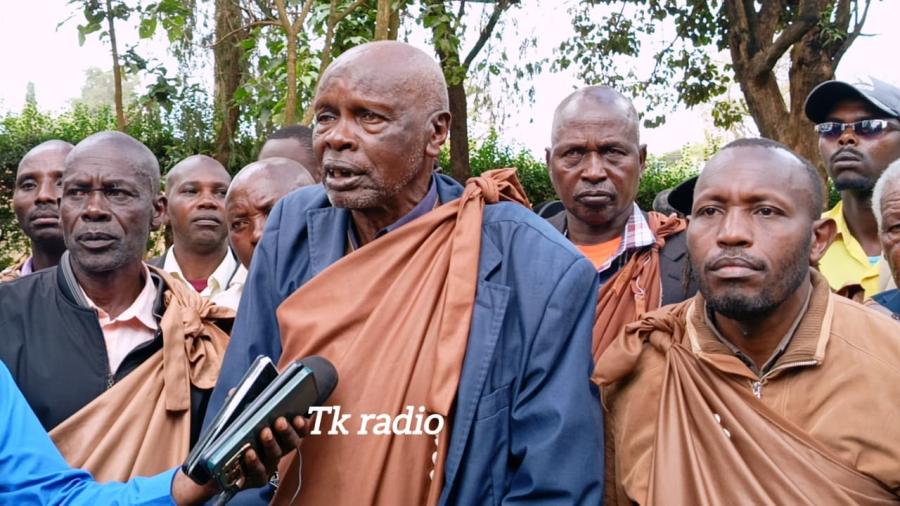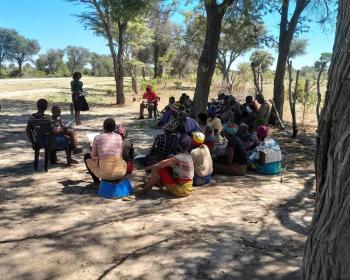Only a small proportion of Namibia’s 38,000 San retain management rights to their ancestral lands. The vast majority, though still residing on the land of their ancestors, have been dispossessed of their natural resources and now live on land managed by others. Only in Tsumkwe District in the Otjozondjupa Region do the San, in this case the Ju|’hoansi and the !Kung, retain partial rights to manage their ancestral land and natural resources. Tsumkwe District, known in the past as Bushmanland, is 17,540 square kilometres in size and is occupied by some 6,700 people, most of whom are San. As people indigenous to this region, the Ju|’hoansi and !Kung have depended for generations on hunting and gathering in order to meet their subsistence and income needs.
In 2000, the Government of Namibia announced a plan to resettle at the heart of !Kung land in Tsumkwe District West more than 20,000 refugees from their present location on private land next to commercial farms at Osire, near Waterberg in the Otjozondjupa Region. Though the government and the United Nations High Commissioner for Refugees (UNHRCR) say resettlement is necessary to alleviate pressure on land and resources (water, for example) and to meet the needs of a rapidly increasing refugee population, the plan is strongly opposed by the local people. "Why is the burden to care for the refugees put on the San?" they ask. "Why is it that the government and the UNHCR accept the complaints of the commercial farmers and act on their behalf and not on behalf of the people in communal areas?"
The impact of an influx of refugees will range from large-scale environmental effects to health changes (sanitation problems and the potential spread of water-borne and other kinds of diseases, for example). Long-term dispossession will result from resource depletion and the usurping of communal residential, agricultural, grazing, and foraging land. Hunger and starvation for elders, children, and future generations are real possibilities. Present San leaders will be outnumbered by refugee leaders. The traditional structure and culture of the San will suffer a heavy blow.
The 4,500 !Kung people of Tsumkwe District West applied two and a half years ago to the Ministry of Environment and Tourism to be granted conservancy rights for the management of their natural resources. The proposed conservancy, called the N‡a Jaqna Conservancy, would cover 8,550 square kilometers and contain sufficient forestry and wildlife resources to guarantee the future of the !Kung and Ju|’hoansi of Tsumkwe District West. Instead of receiving a reply to their application, they heard a proposal to relocate more than 20,000 refugees to their land. The following questions must be asked:
1. Is it appropriate to dispossess one group of people to meet the needs of another group?
2. Is it appropriate to take land away from communal land users in order to satisfy the demands of commercial farmers?
3. What will be the long-term social, economic, environmental, and political impacts of moving a sizable population of refugees into an area already occupied by San peoples, many of whom depend heavily on the land and its resources?
In consultations with local people in Tsumkwe District West in April 2001, residents repeated that San are traditionally hunters and gatherers, and that bush foods make important contributions to household food security in the district. What’s more, the costs of resettling thousands of refugees in the M’Kata area would be much greater than any resulting benefits for the local people. Local people will probably not be hired for the relatively few jobs the refugee camp will create. And refugees in the camp will likely place substantial pressure on the soils, grazing, wildlife, bush foods, and other area resources, reducing access to these resources for everyone in the region.
While Namibian government officials promised that the San community would share in the development the refugee camp would bring to the area, no plans exist at present to provide compensation or development assistance to the host population. Though Namibian government policy aims to increase the self-sufficiency of the country’s people, the relocation of the refugee camp will serve to increase the San’s dependence on the government. And there is a danger that the geographic concentration of large numbers of refugees will distance San people from their normal means of livelihood, weaken their social and political cohesion, and cause negative economic and cultural impacts.
I recommend that the Namibian government look for a more suitable place to relocate Osire’s refugees. A comprehensive environmental impact assessment and a social impact assessment should be conducted prior to a final decision about the relocation to Tsumkwe District West. The Namibian government and the international community should assist the San and not continue to exploit them and their resources. The San have given enough over the past several centuries. The time has come to assist them in their struggle for development and human rights.
This article is adapted from an address to the 19th session of the UN Working Group on Indigenous Populations, Geneva, Switzerland, 23-27 July 2001.



